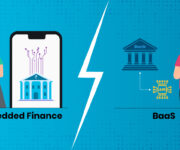The past few years have seen the growth of financial services and digitisation via adopting newer methods for wealth management, payments, insurance, and lending.
Consequently, the digital lending sector is undergoing a similar transformation to overcome traditional banking pain points and highlight financial inclusion by offering individuals, and businesses access to financial services and products.
Therefore, businesses of different sizes and stages of development are exploring and preparing to introduce embedded financial services to serve business and consumer groups, including retailers, telecoms, huge tech and software companies, vehicle manufacturers, insurance providers, and logistics firms.
What is Embedded Finance?
Customers like the convenience: a small business can get a bank account through its accounting software, and a client can pay through the merchant.
Embedded finance brings together Banking-as-a-Service (BaaS) and Application Program Interfaces (APIs) to integrate financial services for any company. This is increasingly giving rise to financial intermediaries, basing its roots from the presentation of Angela Strange of Andreessen Horowitz, titled: Every Company will be a Fintech Company.
Also read: Banks and FinTech: Rivals or Partners?
Embedded finance combines both non-financial companies and financial institutions. This helps in market restructuring to serve business and consumer segments. This means a telecom company can also become a loan provider. For example, a clothes retailer can offer buy-now-pay-later (BNPL) financing schemes as customer preference.
The LightYear Capital investment fund estimates that embedded finance services will be worth around $230 billion in revenues, and the stock market value of the companies in the sector could reach almost $1 trillion by 2025.
Use cases of Embedded Finance
Below are some of the most widely used cases of embedded finance:
1. Retailers and Manufacturers
Embedded finance solutions give high margin revenue for these companies. In addition, retailers and manufacturers can generate new revenues from supply chain finance.
2. Bank-like Services
Retailers can offer third party banking services for purchases without customers having to leave the original website: result, faster deal-closing and qualifying sales.
3. Digital Wallets
Digital wallets use digital versions of credit/debit card versions that help with convenient payments for consumers without revealing sensitive information.
Also read: Google’s Entry in Indian Retail Banking: The Challenges & Implications
4. Healthcare Services
Healthcare services offer embedded lending to help pay medical bills with no interest, no additional fees and even EMIs in some cases.
5. Insurance
Insurers can use the model to generate revenue from new distribution channels and debit/credit services with faster payment processing and claims.
6. Ride-hailing Apps
With embedded finance in ride-sharing apps, consumers can pay at the point of purchase without having to look out for borrowing money.
How can Embedded Finance help the Digital Lending Industry Evolve?
Embedded finance is the new addressable market opportunity for a multitude of causes. Zooming in on the digital lending sector, embedded finance leads to individuals and businesses lending and borrowing between each other.
For non-financial companies, this means engagement, customer retention, and diversification of revenue. This also ensures the democratisation of services with the manifestation of:
- New digital applications
- Alternative processing networks
- Alternative credit models
- Non-traditional data sources
- Lower operating costs
- Customer-centric lending processes
The financial fabric is tightly woven into broader issues, and digital lending is one of the use cases, which provides ample scope for augmentation.
Companies are pushing their way into consumer lending without triggering bank-level regulations where people can seamlessly avail of personal loans or credit lines. In doing so, companies also cater to one of the biggest emerging trends – demand for integrated experiences.
Customers are flocking to multiproduct customer experiences, known as ecosystems, according to a McKinsey study. Ecosystem orchestrators, by definition, strive for maximum integration; therefore, an embedded integrated financial solution fits the concept nicely.
Also read: Instant Loans – Fintech Innovation that Customers Are Loving
Consequently, digital lending is rapidly gaining ground in India as enterprises and users continue to support lending money online across the entire value chain of lead generation, customer onboarding, underwriting, and loan disbursement.
Emerging business models in digital lending
With the current global crisis and ever-evolving digital solutions, lending has risen above brick-and-mortar business, helping individuals and businesses to stay afloat through bad times. But, unfortunately, traditional lending processes are no longer fit for current times.
With the advent of open banking and fintech marketplaces, lenders can perform risk assessment and credit scoring through the entire loan cycle. This makes use of APIs designed by third-party providers to access customer data like credit card accounts, insurance information, inventory, etc. These collaborations, along with digital lending platforms, help with faster loan disbursement, save person-hours, and increase efficiency.
Some of the innovative digital lending business models are:
-
- Peer to peer (P2P) lending: This business model is 100% tech-driven that connects you directly to borrowers through a P2P online platform by matching lenders with borrowers. P2P lending works best to finance entrepreneurs and start-ups. There is no involvement of any financial institution since lenders can choose the borrowers. Here, lenders can earn higher interest rates while borrowers can avail of loans at a lower interest rate.
- SME lending: Access to traditional funding is a massive struggle for small- and medium-sized enterprises (SMEs). SME lending fulfils the requirements required by small businesses like marketing, new product launch, hiring new employees, etc.
- Marketplace lending: This uses online platforms where borrowers can connect with investors willing to offer loans. Marketplace lending helps cut costs and streamline loan approvals. Many large financial institutions will partner, build, and buy to provide their marketplace lending products and services with time.
Fintech of the Future
The current economic crunch has wiggled its way through innovation from white-labelled credit cards to digital payment options. In the future digital lending landscape, embedded finance will make valuable ground throughout the loan lifecycle to support its growth in years to come.
Also read: Finezza Among the Key Enablers in the Novel Account Aggregator Ecosystem in India
Finezza is committed to help fintech companies meet their most pressing credit and lending challenges by providing unique digital solutions and integrations. Contact us to know more about our offerings.




Leave a Reply